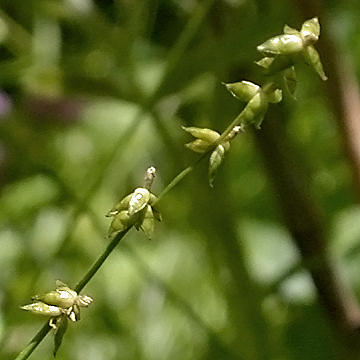

Carex radiata - (image 1 of 6)
Taxonomy
Family: Cyperaceae
Section Phaestoglochin
Once misapplied to Carex rosea.
Habitat
Moist, mesophytic woods and wet depressions. Tends to occupy wetter areas than does C. rosea.
Associates
Distribution
Nova Scotia and southern Quebec west to Manitoba and ND, south to NC, AL, and MO.
Morphology
Tufted perennial; stems erect, slender, to 80 cm; fertile stems 0.8 to 1.5 mm thick at the base; leaves narrow, to 1.9 mm wide; sheaths tight, only slightly thickened at the summit; spikes 4-7, androgynous, sessile, less than 1 cm wide; bracts setaceous, the lowest often surpassing the inflorescence; perigynia 2-20, light green, 3-4 mm long, the beak serrulate-margined, reflexed at maturity; scales persistent, light tan with a dark midvein, shorter than the perigynia; stigmas slender, straight to twisted or recurved, red-brown, slightly longer than the beaks; achene lenticular, ovate to obovate, occupying only the upper half of the basally subtruncate perigynium.
Notes
Fruiting April to June
Wetland indicator: FAC
Can be distinguished from C. appalachica and C. rosea by the uncoiled stigmas and the achene which only occupies the upper half of the perigynium (the achene occupies more than half of the perigynium in the other two species). Additionally, C. rosea tends to have wider leaves and C. appalachica has perigynia that are ascending to spreading but not reflexed. Often occurs in the same habitats as C. rosea but associated with wetter microsites.
References
Curtis, L. 2006. Woodland Carex of the upper Midwest. Lake Villa, IL.
Gleason, Henry A. and A. Cronquist. 1991. Manual of Vascular Plants of
Northeastern United States and Adjacent Canada. Second Ed.
The New York Botanical Garden. Bronx, NY
Swink, F. and G. Wilhelm. 1994. Plants of the Chicago Region.
Indiana Academy of Science. The Morton Arboretum. Lisle, Illinois.
|
© Michael Hough 2010 |